Cookie Monster
by David "Shorty" Routh
Introduction
I have been a girlscout leader for the past couple of
years, and when we recently moved to Phoenix Arizona, I started up another
troop here. There is a local organization that hosts a yearly cardboard boat
regatta, and each year the Girl Scouts have entered a boat. Here is a picture
of the boat they entered in 2004. There are more pictures of some of the other
boats from 2004 at the Rotary River Ralley
website
The boat did OK, it came in a resonable time but no where near
the front of the pack.
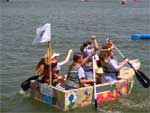 click images to enlarge
click images to enlarge |
I responded to the email that Margaret (the
program director) sent to all of the leaders looking for people interested in
participating in this years boat building. I showed her my website and tried
to sell her on my skills, even though I have never built a cardboard boat
before. She gave me the job to be in charge of organizing and building the
cardboard boat for this year, and expressed a strong interest in making a fast
boat, and doing our best to win one of the classes.
Being a Puddle Ducker, my mind started to race with
all sorts of neat possible rule benders and loop holes like using fabric and
Titebond II glue as the skin, sort of like a poor man's fiberglass. I called
up the Rotary River people to request a full set of rules, the tutorial and
also pick their brain about what was allowed and not, and what works. There
are several classes, and the one I felt best to go after was the "Class 1,
Youth" which requires that:
All boats must have 14 yrs or younger people in
it, be made entirely from corrugated cardboard, and propelled by only kayak
paddles, canoe paddles, or oars. Single part glues and paints are allowed, but
no 2 part glues.
Not Allowed:
fabric (was going to
impregnate with TB2)
rope
paper (thinking paper machet &
TB2)
Is Allowed:
tear apart cardboard, and smash it, glue it
however
any type of tape, if used on seams only
caulk / PL
Premium
polyurethane
elastomeric roofing paint
up to 40' length
overall
up to 10 paddlers in the boat
Things that are allowed,
but don't work:
Oil based paints and coatings
Suggested
Construction:
Glue cardboard together using elmers yellow constructino
glue (I'll use TB2), caulk the edges, paint heavily with polyurethane (which
is strange because it is oil based), then paint with latex exterior (also
strange, because I heard latex falls right off polyurethane). Strongly pointed
out to coat both inside and out of the boat, because the water water gets
splashed inside and destroys from the inside out. Here is a tutorial.
The Course:
The course is approx 200 yards long, has a long
straight section, then a 90 degree left turn, and another 120 degree or so
turn to return back to the start line. A gang of 4 to 6 boats start at the
same time, and evidently often pile up at the first turn where many of them
capsize. Each boat's time is recorded individually, and the fastest of the
boats go to the next heat. There is no specific percentage or number of boats
to progress, it is all a matter of what they feel like that day. Sportsmanship
is encouraged, but there are no rules against fouling or purposely interfering
with another boat. (** This is an aggrevating point, I only found this out
after a week of working on the project, had I know this up front, the project
might have a different tone) The fastest boats complete the course in about 2
minutes, making it around 3.5 mph. I heard that in Heber Springs AR, a 14.5'
solo kayak did the 200 yd course in 45 seconds.
Taking The Gloves
Off:
While talking to the official at Rotary River, I described how we
were going to try and be serious to take first place in the class. He told me
several times that there was just no way that girls could compete, and that we
really should make a big cookie box or something to get some TV time. The
first time he said it, I chuckled a bit thinking he was joking, but then he
reinforced his statement as being serious. That just completely irked me off!
And obviously he had no idea who the @*&% he was talking to.
The Plan
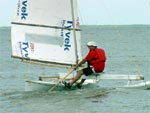 I was steaming from the comments that the regatta person
said, and as I hung up the phone, there was only one person to contact -- Milton "Skip" Johnson . He is a world class
designer of racing canoes and kayaks. People literally spend thousands of
dollars on exotic fabrics and resins to build his designs for the most serious
of paddling races around the world. The photo above is one of the many
boats he has designed and built, it was for a $50 sailboat race. In that
race, all the boats had to be made with $50 or less of materials. Most of the
boats entered in the race were various forms of trash that was duct taped
together, leave it to Skip to push it to the max.
I was steaming from the comments that the regatta person
said, and as I hung up the phone, there was only one person to contact -- Milton "Skip" Johnson . He is a world class
designer of racing canoes and kayaks. People literally spend thousands of
dollars on exotic fabrics and resins to build his designs for the most serious
of paddling races around the world. The photo above is one of the many
boats he has designed and built, it was for a $50 sailboat race. In that
race, all the boats had to be made with $50 or less of materials. Most of the
boats entered in the race were various forms of trash that was duct taped
together, leave it to Skip to push it to the max.
About Skip's $50
Boat
Let me digress for a moment - the boat type in the photo is called
a "proa". Most sailboats will "tack" in the wind, meaning it will go back and
forth as it goes upwind. A proa will "shunt" which means that instead of
taking the wind over the other side, it will change directions and sail
backwards, so the wind always blows over the same side of the boat. The sail
is made of Tyvek that I belive came for free from a construction site
dumpster, that was the only thing he got for free. The big hull and the small
hull both came from 2 sheets of luan. It looks like they have decking on top,
but they really have more tyvek to keep the water out. The cross beam he is
sitting on is actually made from cardboard, covered in paper with clear tape.
I gently squeezed it at the race, it REALLY IS cardboard. For more info, see
the $50 race and
messabout page.
Back To The Plan:
Ok, so the plan at
this point is simple:
1 - recruit Skip to design a fast boat for us.
2
- recruit the best girls I can in the 11 to 14 year old range
3 - build a
prototype boat from plywood, and start practicing
4 - build some test
pieces, test materials
5 - build a cardboard boat for testing
6 - build
the final boat for the race
Advantages We Plan To
Exploit:
1 - sexy boat design - the tutorial on boat building
and the boat building clinic teacher all preach that the boats should have
flat sides to them, and that they should NOT be curved in any way stating that
they will loose strength. Skip ran some simulations on a 12' box with pointed
ends compared to a coventional design that he would make, and found that the
pointed box will have between 2x and 6x more drag !
2 - power to weight
ration - not exactly sure on our crew makeup at this point, but generally
speaking in the age range, girls tend to be lighter and have a better power to
weigh ratio. So we are looking to combine the right combination of paddlers
with the lighest boat possible.
3 - practice - I heard that most of
the other teams build their boat a week before the race, and the first time
they use it is in the race. Getting our girls exercised, in shape and on the
water will prove to be a big factor.
4 - motivated spirit - the
most important factor is the hearts and guts of the girls driving the boat.
I'll do my best to draw out the best in the girls, so they can reach their
full potential.
I explained the cause, and Skip came on board
immediately. He came up with some really radical ideas, but because of the
gang start, a lot of the exotic stuff had to be tossed out the window. Also
since it is his first cardboard design (and my first one to build), we should
probably stick with a simple solution.
For practice, my friend Tim
Webber came up with a brilliant idea, we could take the plywood boat and
launch it in my pool, and tie both ends to the tree and fence, so the boat
won't go anywhere, but will be a convient place for the girls to practice
their paddling. I tried it by myself with my Plank Rat and it works
really well. Not exactly the same as being free, but a very good simulation
for both technique and exercise.
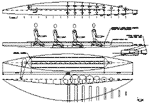 Cookie Monster
Cookie Monster
Here is the first version of what Skip designed.
She is to be built 18' long, has a maximum beam of 28", and
carries 4 paddlers.
The design should translate well between plywood
and cardboard. Can't wait to build her and start testing in the water.
Building The Prototype
The prototype boat is to be made
quick, cheap and dirty from 1/4" plywood. She will be used for practicing, and
after the race, she will go live at one of the girlscout camps to be used by
scouts and hopefully by future cardboard boat teams.
3-4-05
I quickly cut the blanks to be used for the sides and the
bottom. The sides are a maximum of 8" high, and that just happens to fit thru
my table saw. Also you might notice that both the sides and the bottom panel
can come from the width of a single piece of ply, so I just made a couple of
sheets take trips thru the table saw and laid them on the ground with butt
joints to cure. |
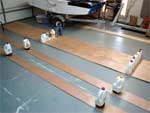 |
|
|
|
3-11-05
I have been sick the past week, felt a little better so
worked on making the paddles. |
|
3-12-05
Put the chines and gunnels on the sides, going to make this
an external chine boat. |
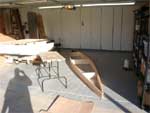 |
|
|
|
3-14-05
Put the bottom on, also epoxied the bow and stern with a
bunch of sawdust as a filler. Thinking about adding in 2 more skids just to
make the bottom rock solid. |
|
3-18-05
I finished decking as per plans, added the bow, stern, and
side decks. The butter tubs are a poor man's access hatch, also another
invention that Skip came up with - but he usually uses rubbermaid containers.
|
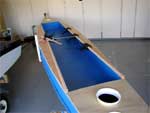 |
|
|
|
3-20-05
Being a double ender, you might
not know which is the bow and stern, so I painted on my typical scheme. The
cardboard boat will be completely painted by the girls any way they want. |
|
Testing Cardboard
Before I spend a bunch of time
building the cardboard version of the boat, I wanted to do some testing to
figure out what the layup schedule should be. (order of materials). The
tutorial said to use lots of polyurethane, but also said not to use oil based
products because the oil broke down the glue in the cardboard. Not only is
polyurethane oil based, but it is $37 a gallon. Also I am hoping to use gummed
reinforced tape, which is a tape that you wet first and then stick on, so I
wanted to find out if it would soak thru and release.
So I made 2 test pieces.
ONE: (on the right)
2 pieces of cardboard,
laminated with TB2
PL Premium (concrete blend) on the edges
one side
painted with TB2
entire outside painted with latex paint |
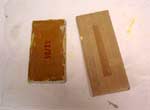 |
|
|
|
TWO: (on
the left)
2 pieces of cardboard, laminated together with TB2
edges
covered with gummed reinforced tape
latex paint all over |
|
Testing Results
After the paint was dry, I
used duct tape to cover a couple of holes in the ends. Then I placed both
pieces in my sink, filled it with water and put a coffee cup on each sample to
hold them underwater. After 20 minutes, all of the cardboard that just had
latex paint on it was completely soaked, but all cardboard protected by TB2
was dry. Interestingly on sample ONE, the outside of one side was painted in
TB2, and the inner layer was coated with TB2 when laminating the pieces
together. That inner coating of TB2 stopped the moisture from crossing over.
Also the paint could easily be scratched off the surface of the TB2, but later
when dry it was again stuck to the TB2 very well. The PL Premium did a good
job of keeping the water out of the edges. The gummed reinforced tape was
still sticking good to the cardboard, but on the edges where the tape was
soaked, it was softening and could easily be torn.
Layup
Schedule
Think the layup schedule I'll use is to laminate the cardboard
together with TB2, then glue the edges together with PL Premium since it is
such a good gap filler. Use the gummed reinforced tape over each of the seams,
then paint it all with TB2. On top of that, paint with the latex paint for
decoration.
Paddling Practice
2 out of the 3 girls recruited so far were able to
make the first practice. They practiced paddling together in sync, to one
side, the other side etc.
At first, I wasn't sure if the boat would
hold 4 girls at a time, but as you can see in this photo that they do fit OK.
Only one slight hitch as the girl in the back kinda whacked the girl in the
front with her paddle, but that is why we are practicing. |
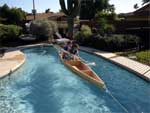 |
|
|
|
To give them an intuitive lesson on how a kayak is
moved around, I had them paddling the little kayak and they did great till it
was almost time to go. Then they "accidentally" fell in several times. |
|
And fell in a couple of more times....
|
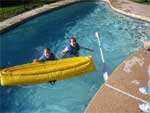 |
|
Paddling Practice At The Lake
|
|
This is our first trip to
Tempe Town Lake, and 3 of the 4 paddlers could make it. |
|
Lucky for us, there is a permanent set of bouys out in the lake
that are almost just right for us to run around. The first time they went
around, the boat zigged and zagged all over the place.
After a few
trips around, they started getting better and I noticed that they have plenty
of power, the only thing we really need to work on at this point is getting
them to work together effectively.
After a couple of more trips around the bouys, their time was
still around 10 minutes to go out and come back. I pulled 2 of the girls out
and had just one paddle by herself, and she did it in 4:10. Then the 2nd girl
went, came in at 4:50, and the third girl went (who was the smallest) and she
came in at 3:50 !!! So the first girl went again by herself and she made it
back in 3:22.
That was really good to demonstrait to the girls how
fast they could go, so we put 2 girls back in the boat and they made it back
in 5:20. |
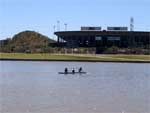 |
|
The next step is to put a big skeg on the back (big fin, works
like a fixed rudder) to help make the boat paddle straight-er. It will be
harder to turn that way, but I can always cut it back off if it proves too
dificult.
More
Paddling Practice At The Lake
After a couple of practice sessions, it
was looking like the best time was with less girls. A single girl by herself
could beat the entire team working together.
|
|
All sorts of combinations were tried, and the fastest times
around the bouys and back was having 2 girls in the boat. |
|
Later when
at the race, I found out that the 2 most popular combinations of crew are
either 2 people in a light skinny kayak, or a big catamaran (two hull) with
the max number of 10 crew. The 2 person crew can turn the corners sharp, but
don't have the higher speed. The super boat with 10 crew is faster, but they
can't turn the corners very well because of so much inertia.
I
contacted the council and they registered a 2nd boat, so we will be racing 2
identical cardboard boats, each with 2 girls in them. Works out great, we have
a total of 4 girls, so now everyone can run all of the races.
|
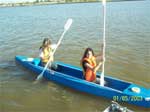 |
|
Turning around and changing places in the boat is
part of the small boat patch, so they were doing a little extra work besides
paddling practice.
The Photo Op
Bright and early at 5am on Friday, the media held their own
mini-race and anyone with a cardboard boat that showed up got to be on TV too.
|
|
We brought all 3 boats down to display. |
|
This is the trophy hat that the winning media person would get to
keep. The same guy has won the past 3 years in a row. |
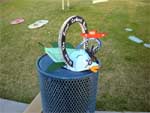 |
|
|
|
They went around and interviewed us all live on TV. |
|
Then we took the boats over to the storage area at Tempe Beach
Park. You can see that the skeg was damaged previously, and it looked like it
was going to fall off in the road!
Later on I glued it back on, that
was the first of many repairs. |
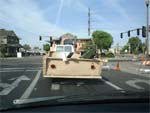 |
|
Some of the competition
The Race
I apologize for not getting more photos of the races, my camera
was having problems and was not working very well.
|
|
Here we are with our blue boat Cookie Monster with our 2 smallest
girls, we are on the far side of the starting line. You can just barely see
the bow with the yellow flag on it sticking forward of the white boat.
All the other boats at the starting line were manned by Boy Scouts. |
|
Then we took the boats over to the storage area at Tempe Beach
Park. You can see that the skeg was damaged previously, and it looked like it
was going to fall off in the road!
Later on I glued it back on, that
was the first of many repairs. |
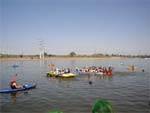 |
|
|
|
The horn blew and we were off!!
The horn
wasn't the only thing that blew off, the Cookie Monster decoration and a bunch
of the cookies we taped to the deck blew off too. Not sure if they were
snagged by another paddler or if they just fell off. |
|
The girls made it past the first bouy and were on their way.
|
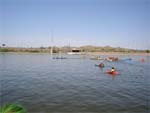 |
|
I think the main reason our girls were able to get
ahead of the rest is because of our weeks of practice and their extreme desire
to win. The Boy Scouts in their yellow catamaran was a superior boat design
which the adults have proven to be much faster and more powerfull. They just
didn't seem to be paddling that hard, and they didn't paddle together so their
boat kinda looked like a splashing mess.
|
|
Here is Oscar the Thin Mint heading for the launching
chute. |
|
Our 2 bigger girls manned Oscar. They lined up at the start line
and had a start similar to the blue boat. When they got to the first turn,
they unfortunately cut just to the inside. While the boat did touch the bouy,
I don't think the girls understood the importance of going around the outside,
so they continued on and were disqualified. |
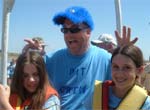 |
|
They did great regardless, and are
still young enough so they will probably enter again next year in the youth
class.
Conclusion
|
|
We were able to win all 3 heats and won the class 1 youth division.
|
|
We stopped by the judges trailer and Jim Lemon let us get a picture with him.
He is the main organizer and purchased the territory rights to hold cardboard
boat races in our area, this is the 6th regatta he has organized and it is the
largest of all the cardboard boat races in the world. Thanks a bunch for
organizing the events Jim! |
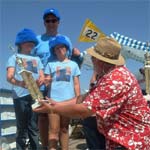 |
|
We made a good team and it was a ton of fun.
I have known about the cardboard boat races for about
5 years but always viewed it as a waste of time. Having been thru the process,
I can see the light now. Once a year you get an opportunity to build another
boat that actually has a purpose, but afterwards you don't have to take it
home to clutter up your yard. The cardboard construction is very quick, you
can cut corners just about everywhere and it doesn't matter. There are many
other goals to build a boat other than winning the speed contest, they have
the Vogue, Pride Of The Regatta, Best Dressed Team, Team Spirit, Titanic,
Rotary Cup Challenge, People's Choice, and other awards.
|
|
Next year,
Margaret hopes to get 4 or more teams entered into the race, and I plan on
entering my own personal boat, and possibly collaborating with others to make
large boats for the max of 10 crew |
|

